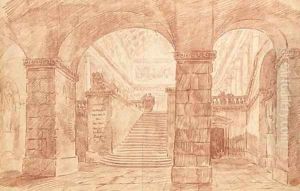Jean-Robert Ango Paintings
Jean-Robert Ango was a French artist born in 1710, whose contributions to the art world, though not as widely recognized as some of his contemporaries, remain significant for their detail and craftsmanship. His life and career unfolded during a rich period in French art history, marked by the Rococo style, which was characterized by elaborate ornamentation, asymmetrical values, pastel color palettes, and often, themes of love, nature, and light-heartedness. Ango's work, however, also displayed an early inclination towards the emerging Neoclassicism, a style that sought to return to the simplicity, order, and ‘purity’ of ancient Greek and Roman arts.
Ango's upbringing and early life are not extensively documented, but it is known that he was active in the mid-to-late 18th century, a time when France was a leading center of art and culture in Europe. His training likely involved apprenticeship under established artists, as was customary at the time, allowing him to master the techniques and styles prevalent in his era. Throughout his career, Ango developed a reputation for his detailed and precise drawings and engravings, which often depicted classical themes and landscapes, aligning with the Neoclassical movement's ideals.
Despite his skill and the quality of his work, Jean-Robert Ango did not achieve the level of fame and recognition that some of his peers did. This could be attributed to various factors, including the possible overshadowing by more prominent artists of the time or the specific nature of his contributions, which may have been more subtle and less aligned with the dominant tastes of his era's art patrons. Nevertheless, his works are valued by art historians and collectors for their beauty and technical proficiency.
Ango's death in 1773 marked the end of a career that had navigated the transition between Rococo and Neoclassicism. His legacy, though not as prominent as that of some of his contemporaries, provides an interesting study for those interested in this pivotal period in art history. His life and work reflect the complexities and shifts in art styles of 18th-century France, making him a figure of interest for scholars and enthusiasts of French art history.
